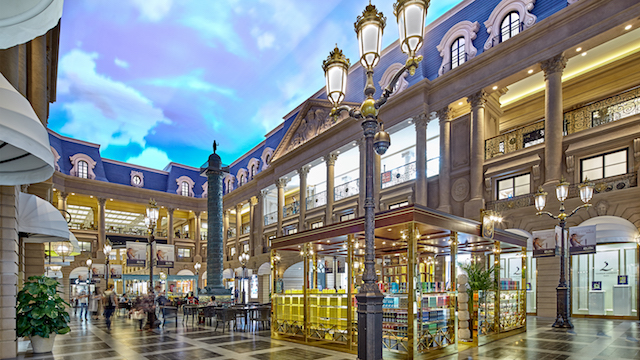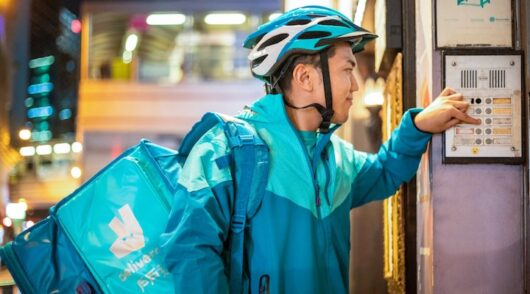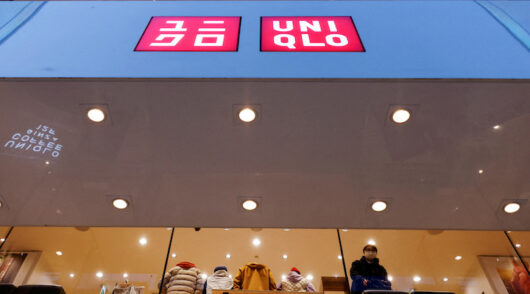A little over a decade ago, what we now know as The Cotai Strip was but a giant reclaimed sandbox connecting what were previously two islands of the former Portuguese colony Macau.
Towards one end a collection of cranes were lifting giant piles into place, creating the foundations for The Venetian Macau, the start of the multibillion dollar avenue of luxury resorts, hotels, casinos and shopping centres – literally the product of a dream of US billionaire Sheldon Adelson.
This year, The Venetian celebrates its 10th anniversary – which effectively marks the first decade of organised retail in Macau, at least in terms of modern day shopping malls. Before that, the 600,000 or so local population used to head to Hong Kong to shop for brands – or stroll across the border into Zhuhai for essentials at mainland prices.
Now, there are so many malls, pitched at so many price-points that locals no longer need to take the one-hour ferry ride to Hong Kong to buy fast-fashion or cosmetics. Pretty much everything is available at the Cotai Strip or on the main island.
Between 2006 and 2014, Macau was posting retail growth of between 20 per cent and 30 per cent annually. The subsequent Chinese central government clampdown on travel, corruption, gift-giving and currency flows, designed to temper mainlanders’ gaming activities has impacted on Macau’s visitor numbers. And thus retail growth has slipped into relatively mild decline.
The Government of Macau Statistics and Census service forecasts year-on-year retail sales will continue to decline in 2017 by between 3 per cent and 4 per cent, a slower decline than in 2015 and 2016.
Pascal Martin, partner with OC&C Strategy Consultants, notes more recent government forecasts have been more optimistic than earlier ones, and that gaming revenues actually posted their first growth in two years in August 2016, albeit just 1.1 per cent year-on-year.
If gaming revenues are rising again, retail revenues should surely follow, because with such a tiny population, visitors are solely driving Macau’s retail boom.
“It could be an early sign that Macau is starting to get back on a positive track,” says Martin.
“Going forward, one can hope that Macau retail sales will stabilise and get back to a positive growth path. But I don’t think that it will ever – at least in the foreseeable future – go back to the 20-30 per cent range.”
The overall anti-corruption environment in China is unlikely to change and this will continue to prevent the high-rollers from showing off their wealth, he says. “Therefore gambling growth will probably stay at low single digit levels.”
Inseparable bedfellows
Gaming and shopping have been inseparable in the rise of retail in Macau. But during the last two years especially, there has been an obvious and concerted effort to develop a more sophisticated and unique retail offer. Resort and casino operators have focused on aggregating brands which appeal to specific price-points and attracting brands not currently in Macau – like jeweller Nirav Modi at MGM – or even in Asia, like Antonia (see our feature on page 28 of this edition).
Besides having first mover advantage in Macau’s shopping centre market, Sands China has the strength of three distinctly different destinations, each targeting a different core, while encouraging overlap through a network of walkways encouraging cross-flow. Combined, the malls boast some 850 tenancies and their host resorts 13,000 hotel rooms – a handy captive audience for retail marketing messages.
The Shoppes at Venetian is very much a high street style destination, with fast fashion brands like H&M and Zara, cosmetics store Sa Sa and a very broad retail offer. The Shoppes at Four Seasons is positioned at the luxury end of the market and includes the DFS Tmall Galleria. And there is the small Shoppes at Cotai on the opposite side of the boulevard, catering to families.
The Shoppes at Parisian, which opened in November, has been positioned as an “affordable luxury” destination with a younger demographic and – fitting the French theme of the resort – most of the retailers are from France, or broader Europe. It is home to a carefully curated collection of modern fashion and edgy brands which bridge the offers of its sister properties.
“We’re not just targeting the luxury buyers,” explains Rita Simonetta, assistant VP of retail marketing, Sands China. Indeed, a shopping promotion running during December offered grand rewards for shoppers spending 100,000 MOP (US$12,500) – but there was a free meal on offer for those who spent the more modest 8000 MOP (US$1000).
“It’s all about catering for the whole market.”
Besides the shopping, the malls collectively offer entertainment including gondola rides and a ride to the top of the replica Eiffel Tower for a view over the Cotai Strip, street theatre and a food and beverage offer ranging from simple food court fare to high tea and Michelin star gourmet.
“We are all about giving an incentive to people to shop here, whether it be the architecture, the entertainment, the street performers, they’re all giving them a reason,” says Donna Campbell, director of public relations for Sands China.
Forty of the 170 retail tenancies at the Parisian are exclusive to Macau. All are located on replicas of famous Paris shopping streets.
“I’ve had friends from France who have said “Oh yeah, yeah” when they hear we’ve built a replica of Parisian streets. When they get here they’re surprised,” explains Campbell.
‘Unparalleled’ Boulevard
Alongside the Parisian is Melco Crown Entertainment’s Studio City which opened in October 2015. Like the Parisian, the resort promised an “immersive retail entertainment environment” in its 35,000 sqm shopping footprint, “bringing shopping to life by ‘transporting’ visitors to high-energy streetscapes… inspired by iconic shopping and entertainment locations, including New York’s Times Square and Hollywood’s Beverly Hills”.
Melco executives declined to be interviewed for this feature so it is difficult to know how its retail strip is performing.
While the resort brought in experienced retail property operator Taubman Asia to plan the tenancy mix and oversee leasing, several strolls around the retail space at different times of the day suggest the centre is struggling to attract as many shoppers as Sands’ properties. In part that’s because the stores are spread over a single story, along wide curving indoor corridors around the casino, entertainment and hotel operations, rather than concentrated in one place. It has the feel of stores being situated to line walkways rather than stores being positioned to attract shoppers.
At the time of the opening, then president of Taubman Asia, Rene Tremblay, said the boulevard brought an “unparalleled shopping experience” to Studio City.
“In this unique space, Taubman Asia delivers a mix of contemporary luxury and bespoke shopping options, all artfully curated by our team of experienced retail experts that has spent years carefully researching the market and creating an experience tailored to the needs of Macau’s many visitors.”
Retail brands at Studio City include the first Balmain in Macau (featured on the following pages of this issue), the city’s first Belstaff and Tom Ford’s largest store in Asia.
The Beijing factor
With China’s central government trying to shift the focus of Macau away from gambling towards integrated resorts, events and MICE (meetings, incentives, conferences and exhibitions), the newest resorts have a far smaller casino footprint than the earlier ones, especially those built in ‘old Macau’ prior to the current gaming boom. The new MGM Cotai resort in the final stages of construction has just 10 per cent of ts total area dedicated to gaming.
MICE attracts more dedicated shoppers than casinos. A recent Mary Kaye convention drew 10,000 women, many of whom were spotted walking the malls carrying as many as 10 branded shopping bags.
MICE might also influence the demographic of visitors to Macau in future years, opening up new opportunities for retail in the city.
Mainland Chinese account for about 80 per cent of Macau’s visitors. Hongkongers are the second largest visitor group, then it’s a long gap to Taiwanese, Koreans, Japanese and a growing Indian visitor base.
Marketing Macau as a visitor destination is essentially a numbers game. With 120 million Chinese within an hour or two’s flying time from Macau, there is little incentive to promote the destination to 23 million Australians, for example.
The average length of stay for a visitor to Macau used to be 1.2 days – that has stretched to 1.5 days now and the resorts are working with the government to lengthen it further to two days.
Macau’s retail explosion is not restricted to the resort-linked malls. Some of the other casino and entertainment complexes are finding incremental benefit in retail as well. Such as MGM, one of the original western-linked complexes to open in downtown Macau before the advent of the Cotai Strip, with around a dozen fashion retail spaces and an additional food and beverage offer.
“The market for us is changing,” explains Juliana Kung, PR manager with MGM. “It used to be top, top luxury but we’re starting to see a move to premium and mass fashion outlets.
“We don’t think top end niche is a good fit right anymore. It is more about what is unique now.”
Furla opened its fourth Macau store there in December and Tudor recently opened as well. More food and beverage tenants are moving in soon. Some of the gaming floor has made way for new retail stores with tenancies yet to be announced.
This property doesn’t consider retail stores to be a major driver of foot traffic – with the possible exception of its unique Nirav Modi store which opened last November, it generally sees stores as a complementary offer to gaming and accommodation for those already onsite. They also provide an upmarket extension to customers of the seamlessly connected multi-story One Central mall – owned by Pansy Ho who is a stakeholder in MGM – with its decidedly more mid-market offer.
Hold the enthusiasm
Not everyone is as bullish about Macau’s retail future as the resort developers. Pascal Martin says that while recent mall openings and extensions have dramatically expanded the city’s available retail space, he believes the market is probably starting to face a situation of over-distribution, particularly for luxury brands. Much as experienced in Hong Kong. “Therefore OC&C predicts that few brands might be closing a few stores, as we have seen in Hong Kong recently.
“In order to move the needle toward becoming a true family-oriented tourist and retail destination, away from just being a gambling destination, Macau may have to plan and develop a more ambitious multi-activity leisure park, on the model of what Singapore did on Sentosa. Not just updating its seafront attractions.”
Martin believes that although the more recent openings like the Parisian are putting more emphasis on shows and entertainment in addition to gaming – and renovations are being undertaken on outdoor amusement facilities – Macau is still very far from having the critical mass of quality dining, shows and entertainment that would be needed to start to attract crowds of tourists for activities other than gaming – as Las Vegas has successfully achieved.
“Therefore, we don’t see entertainment driving sufficient new growth and therefore new retail growth yet.”
Developers seem undiscouraged. The next major complex to open is the futuristic ‘jewel box’ designed MGM Cotai, in the second quarter of this year. It will have a retail component of which few details have yet been released, other than a promise to offer “innovative culinary retail and family-friendly offerings for international visitors and locals alike”.
Hong Kong erosion?
One of the key questions about Macau’s retail growth is the impact it is having on Hong Kong retail.
In 10 years Macau retail has expanded from a collection of poorly merchandised local jewellery and electronics retailers and scattered luxury brand stores attached to hotels into a sophisticated collection of retail shopping centres. Surely this must be having some cannibalisation of Hong Kong’s beleaguered retail sector?
Perhaps surprisingly, no-one believes so.
David Sylvester, EVP, head of global retail at Las Vegas Sands Corporation, agrees that some Mainland Chinese who would in the past have stopped in Hong Kong for some shopping before heading to the Macau casinos are now heading straight to Macau, but he believes the total volume of sales lost to Hong Kong is “not significant”.
Sylvester also notes that Macau retailing seems to have turned the corner after a tough two years and begun its rebound ahead of Hong Kong. And he suggests Macau retailers’ attitude has been more positive than the prevailing emotion of Hong Kong.
Martin says for Macau to take measurable business from Hong Kong retail, it would have to have something distinctive that Hong Kong cannot offer.
Such options include:
- Better prices, which he considers unlikely unless Macau decides to convert into a large factory outlet mall.
- More brands or retail formats not available in Hong Kong. “That has not happened so far, but there might be opportunities for big box store formats that do not exist in Hong-Kong, such as multi-brand sports stores like Decathlon, or large DIY stores like Kingfisher, or home improvement centers or furniture centers that would justify a long drive, (when the new bridge under construction shortens the road trip between the two cities to about one hour).
- More attractive, larger stores with better assortment, which he considers a possibility, leveraging lower rent levels than in Hong Kong.
All that accepted, until Sands opened The Venetian in 2007, Macau residents were usually forced to take the hour long ferry journey to Hong Kong to buy fast fashion or – well, anything other than the super luxury designer label goods available at the city’s five-star hotels. Now they can browse goods from all the mainstream brands without leaving town. And some mainlanders are shopping and gambling in Macau rather than shopping in Hong Kong and gambling in Macau. So there must be some impact.
But given the sheer scale of Hong Kong’s retail market, it simply is not significant enough to have any measurable effect on overall sales. Yet.
* This feature originally appeared in Inside Retail Hong Kong magazine print edition. Visit our online store to order your own digital or print subscription to the quarterly magazine.













